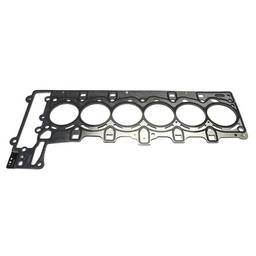Your average internal combustion engine is a mechanical work of art. There’s so much going on in there at any given moment. The violence of controlled explosions, the valves that open and close thousands of times every minute, perfectly choreographed. With that said, there’s a duality in every engine between its need for cooling and lubrication. Keeping these two systems separate, and much more is the job of head gaskets.
What Are Head Gaskets?
A head gasket is a flat piece of material that forms a seal between the cylinder head and the engine block. Its main purpose is to keep the oil and coolant that flow through the head/block separate. Allowing coolant to get into engine oil is never a good thing. Having water end up in the engine, oil is one of the fastest ways to nuke an otherwise perfectly fine engine.
Head gaskets aren’t all created equal. There are different types of gaskets out there, including the MLS, composite, metal, and even silicone gaskets, although those are pretty niche.
- MLS or Multi-Layer Steel Gasket – MLS is among the most modern solutions out there right now. These consist of several layers of metal laminated with elastomer and rubber coating. Overall, this type of gasket offers excellent efficiency and durability.
- Composite – Composite head gaskets are often found in older vehicles and consist of metal rings laminated with some compressible kind of material that is more likely to form a proper seal around all of the coolant and oil passageways.
- Metal – Another common type of gasket is a metal gasket. Using a thin piece of metal may not seem like an excellent way to seal anything properly, but it works rather well. All metal gaskets offer better heat resistance and are generally more durable. You’ll often find them used in racing or high-performance cars.
How Long Does a Head Gasket Last?
Head gaskets, no matter the type, should last you anywhere from 100,000 to 150,000 miles at the least. We say ‘should’ because there’s plenty of factors to take into account. The temperature is a big one. An engine that is running hot and overheating is at risk of head gasket failure either due to direct damage to the gasket itself or due to head warpage.
Malfunctions aside, your driving style and maintenance habits can also have a negative impact on the overall durability of the head gasket.
Recognizing the Symptoms of a Blown or Failing Head Gasket
When the head gasket goes, several things can happen. Some of these issues are not as bad nor immediate as others, but they will eventually put your engine out of commission. For one, you can end up with a warped cylinder head, which can put a dent in your wallet. Alternatively, if your gasket goes out the slow and painful way, you might actually find coolant in your oil, or vice versa, depending on which of these two systems is more pressurized.
Oil in the coolant isn’t too big of a deal; however, if you end up with the coolant in your oil, that can be a problem.
We’ve made a simple graphic that will tell you what part of the gasket was blown depending on the symptoms you’re experiencing. Keep in mind that this illustration offers a general rundown of potential symptoms on an average 4-cylinder engine. Your mileage may vary.
1 – White smoke on startup and misfire
These symptoms are caused by a gasket failure between the coolant port and the cylinder itself. As a result, you’ll end up with coolant entering the cylinder, combusting along with the fuel/air mixture, and exiting out back in the form of vapor.
2 – Coolant in oil and misfire
If your gasket fails at position 2, you’ll end up with coolant in the engine oil. A surefire way to know whether this is the case in your car is to check the oil. If it looks like chocolate milk, you’re in trouble.
3 – Failure between cylinders
When a gasket fails between cylinders, it will cause a misfire and rough idle. Gasket failure at this location might be hard to diagnose since misfire and rough idle are both usually associated with a whole range of other, less severe issues.
4 – Coolant leak to the outside
Gasket failure at position 4 will result in a steady coolant leak to the outside. Although less severe than previously mentioned failures, losing coolant can lead to overheating if ignored.
5 – Oil leaking between the head and the engine block
Failure at this position is pretty straight forward. Head gasket failure between the oil gallery passageway or the cylinder itself will result in a steady oil leak.
6 – Oil leak into the cooling system
This one of the scenarios we’ve mentioned earlier. Having a gasket failure between the oil gallery and coolant ports can lead to the oil inside the coolant. Although much better than having coolant in the oil, this type of gasket failure requires immediate attention.
Finding the Right Gasket for your Car
Quality head gaskets are the only way to prevent failure in the future. We offer a wide range of head gaskets as well as intake manifold gaskets for various European vehicles. To find the one that matches your car, head over to our store and type in your car’s year, make and model into our search tool. Once done, you’ll be presented with a comprehensive list of parts.
If your car was produced with a wide range of similar engines, you might want to use our VIN tool. That way, you can get a list of parts for your exact variant. Feel free to contact us if you have any questions regarding the products in our offer. We’re standing by to help!
When doing a head gasket job, it’s important to gather all the other gaskets you need before you get started, to keep the amount of time your car is off the road down to a minimum. eEuroparts sells comprehensive kits for a lot of different cars and engines to make sure you have a complete set of gaskets and seals to ensure re-assembly goes well. These usually include intake manifold gaskets, exhaust gaskets, valve seals (high recommended to do while you have the head off, as old seals will start to leak engine oil into your cylinders). eEuroparts stocks hundreds of head gaskets for all supported makes and models, so if you are doing an engine refresh, be sure to add one of these onto the list to avoid a failure down the road forcing extra work.






I just wanted to thank you for helping me learn more about head gaskets. I actually didn’t know that they were made of perforated metal and have a sealant coating. This makes me interested to see exactly how these are made and what the process is like.